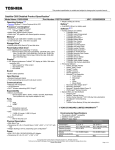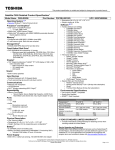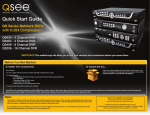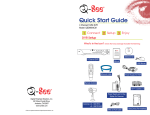Download Q-See QS206 Installation guide
Transcript
Quick Installation Guide For Bundles Featuring the QS206 H.264 Network DVR 16 Channel H.264 Compression DVR with CIF Real-Time Recording PART 1 - PACKAGE CONTENTS QS206 DVR Color Cameras with Stands PART 2 - DVR CAMERA AND POWER CONNECTIONS Manual and Software CD STEP 1: Connect the Cameras to the Cables 1A Connect both camera leads to the matching ends on the power/video cable. Repeat for all cameras. manuals and softwa re QS Serie s QS408 • QS20 6 Attach the BNC connector on the power/video cable to a Video In port on the DVR. Repeat for all cameras. 1B 1C 1 BNC(M) to RCA(M) Adapter Cable Ethernet Cable VIDEO IN Connect the remaining connector to one of the ends on the power splitter. Repeat for all cameras. 2 1 DC +12V IN VGA 3 RJ45 4 USB 5 6 7 1 2 3 4 GND 5 COM1 NO1 COM2 NO2 GND 485A-2 485B-2 GND 485A-1 485B-1 GND +12V GND Pre-Installed Hard Drive ALM IN 8 9 AUDIO IN 10 11 12 AUDIO CVBS OUT OUT 13 14 16 15 STEP 3: Connect the other power supply to the DVR . STEP 2: Connect the single end of the power splitter to the included power supply. Power Supply for DVR Power Supply and 4- or 8-Way Splitter 60-Foot Power and Video Cable (One per camera) STEP 5: Connect thesurge protector to an outlet. STEP 4: Connect both power supplies to a surge protector. IMPORTANT! It is STRONGLY recommended to use a surge protector that is UL-1449 rated. Look for a clamping voltage of 330 or lower, a Joule rating of at least 400 and a response time of 10 nanoseconds or less. Remote Control USB 2.0 Mouse The appearance of contents may differ from images shown. Grounding Cable Not used in North America Revised 6/29/11 PART 3 - CONNECTING THE DVR TO YOUR DISPLAY PART 4 - DVR CONTROLS: FRONT PANEL To Connect to a Computer Monitor: 1. 2. Plug the VGA cable (not included) to the VGA port on the DVR. Connect the other end of the VGA cable to the monitor. To Connect to a TV: Plug the BNC to RCA adapter cable into the Video Out port on the DVR. Connect the other end of the RCA cable to the Video Input on the TV. NOTE! To switch back and forth between VGA and TV, use the Mouse Scroll-Wheel: Forward-switch to VGA Backward-switch to CVBS (TV). Item # Name/ Symbol Description 1 STANDBY Press to set the system in standby mode. 2 MENU/EXIT Press to open/close the main menu. 3 CHANNEL/ NUMBERS/ PLAYBACK Press the number buttons to select a channel and view it fullscreen; press buttons 1-0 to input passwords and user IDs. 4 NAVIGATION/ OK OK VIDEO IN 1 DC +12V IN 1 2 2 VGA 3 RJ45 4 USB 5 6 7 1 2 3 4 GND 5 COM1 NO1 COM2 NO2 GND 485A-2 485B-2 GND 485A-1 485B-1 GND +12V GND 3. 4. ALM IN 8 9 AUDIO IN 10 11 12 AUDIO CVBS OUT OUT 13 14 16 15 ▲ ▼ ◄ ► 3 Press to move cursor up; in PTZ mode, press to pan camera up. Press to move cursor down; in PTZ mode, press to pan camera down. Press to move cursor left; in PTZ mode, press to pan camera left. Press to move cursor right; in PTZ mode, press to pan camera right. 5 LED INDICATORS Shows status of hard drive, recording, alarm, HDD full and network. 6 DURING PLAYBACK PRESS: ◄◄ n/► ► ►►| ►► 4 7 8 IMPORTANT! The default resolution of this DVR is 1024x768 pixels. Some monitors smaller than 19” may have problems displaying this resolution. In menus, press to confirm selections; in PTZ mode, press to change the navigation buttons to control a connected PTZ camera (not included) IR SENSOR Increase reverse playback speed 1X, 2X, 4X. Press to freeze playback to one frame, then press again to advance frame-by-frame. Press to start playback Press to slow playback speed by 1/2, 1/4, 1/8. Press to increase forward playback speed 1X, 2X, 4X. IR Receiver for remote control. USB Connect a USB flash drive for data backup and firmware upgrades PART 5 - ACCESSING THE DVR’S MENUS PART 7 - RECORDING Choose MENU by right clicking on the mouse or by pushing the MENU button on the DVR front panel or remote control. The Main Menu offers the following Setup Features: SEARCH: Search for recorded video on the system. This System offers 3 modes for recording: 1. Manual 2. Time Schedule 3. Motion Detection. RECORD: Enable recording & audio, set resolution & quality, recording mode and file size. HDD: Display hard drive status and format the internal hard drive of the system. BASIC: Open the Basic Setup Menu, which lets you set the system language, date and time, Device IDs and passwords, and configure audio and video settings. ADVANCE: Opens the Advanced Setup Menu, which lets you view system info, configure alarm, PTZ, mobile, and network settings. EXIT: Closes the Main Menu. PART 6 - SETTING UP CAMERAS FOR VIEWING AND RECORDING From the Main menu, select BASIC then DISPLAY. Here you can setup the name display (up to 8 characters) and position of each channel (cameras). Select COLOR SETUP to adjust the image brightness, saturation, contrast and hue settings for each channel (camera). You can also choose whether each channel can be previewed in LIVE MODE and/or RECORDING MODE. NEXT PAGE: Takes you to the settings for cameras 5 through 8, 9 through 12 and 1316 in sequence. From the main menu, select RECORD to enter into the Record Setup menu (shown on the left). SWITCH: “ON” enables video to record from the respective camera. If the channel is set to “OFF”, video from that channel will not record. BITRATE: Select HIGH, MEDIUM, or LOW FRAMERATE: Select 1 to 30 frames per second Using higher Bitrate settings results in better video quality, but takes up more space on the hard drive. Choosing lower settings result in lower video quality, but takes up less space on the hard drive. AUDIO: If audio is ENABLED sound will be recorded with the video from the channels, and will have audio output in playback mode. If audio is DISABLED, sound will not record, and there will be no audio output in playback mode (Audio cameras or a microphone is required to record the sound). REC MODE: select POWER UP or TIMER RECORD. If you select POWER UP, the system will record continuously (Normal Recording) when the system is powered on. If you select TIMER RECORD, you have to set a recording schedule on the system. REC SIZE: Choose the time length of all recorded files: 15, 30, 45, 60 min. (Max = 60 min) The Schedule Grid shows the days of the week and hours 0~23. You can set Alarm Recording (Red), General (Normal) Recording (Green), or No Recording (Blue) to each time block of each day. Manual Recording: From the Record Setup screen set the Rec Mode to “ALWAYS”. Your DVR will continuously record and separate files will be created with the Pack Time intervals you selected. Time Schedule Recording: From the Record Setup screen, set the Rec Mode to TIMER RECORD and click “SCHEDULE”. This will display the Schedule menu (see image above). Select the channels (cameras) that you wish to record on a schedule. The options are: CH-1 through CH-16, and ALL. Click on the green GENERAL option box then click on the boxes for the days and times that you want to record using this option on the timeline. You can use the [From – To] pull-down menus and COPY button to copy settings from one day to another day, or all days. Your DVR will record on it’s Time Schedule, and separate files with the Pack Time Interval you selected. Click APPLY to activate your customized schedule, and then reboot the DVR. Motion Detection Recording: From the Record Setup screen, set the Rec Mode to TIMER RECORD and click “SCHEDULE”. This will display the Schedule menu (See picture above). The options are: CH-1 through CH-8, and ALL. Click on the red ALARM option box then click on the boxes for the days and times that you want to record using this option on the timeline. You can use the [From – To] pull-down menus and COPY button to copy settings from one day to another day, or all days. Your DVR will record on Motion Detection. Click APPLY to activate your customized schedule, and then go to the Avanced option (red box in first below picture) and select the Motion Option (red box in second picture below), which will display the Motion Detect Box. The Motion Detection Menu has 3 sections, including Channel Status, Sensitivity and Motion Area. Status: This option allows you to enable motion detection on any channel. Sensitivity: This option allows you to set sensitivity level of motion detection from 1 to 8, with 8 being the highest. MD Area: Allows you to set the area of the camera view that you want to be sensitive to motion. EMAIL: ON-Open MD alarm to trigger email, OFF-Close MD alarm to trigger email. NOTE: Email alarm can be assigned to each channel Next,�������������������������������� click on the MD AREA SETUP but������������������������������� ton, which will display the picture on the left. This option allows you to select the area you want to be sensitive to motion. You can set this area by using the mouse or REV, FWD, and SEL keys on the front panel. Once you have set the area, right click with the mouse or push the ESC key key to save the setting. After you have set all of the cameras, click on the Apply button to save the settings. PART 8 - VIDEO SEARCH AND PLAYBACK Video Search: From the Main Menu select SEARCH to display the Video Search Menu shown to the right. If you input a specific date and click Search, you will find all the recordings for that day. When you select an item, you will playback the recordings in 16 channel mode; or, click [File list] button to display File list interface, where you can playback or backup the file you selected. See File List heading below. In the playback window you can play video Forward at 2x, 4x, and 8x speeds, Slow play at 1/2x, 1/4x, and 1/8x, or normal play, pause and play frame by frame using the playback control bar, and adjust volume by clicking or sliding tune control bar. When playback has finished, system will return to previous menu. File List: On the Search Menu click the Search button then click File list to display the sub-menu shown in the picture below. This option will allow you to view all of the available files by channel and type (all, normal, or alarm). You can click on a file to playback the file. Use the buttons on the side panel to navigate the file list: FIRST: Jump to the first page of the list PRE: Turn to the previous page NEXT: Turn to the next page LAST: Jump to the last page of the list ALL: Select all files OTHER: Clear all files BACKUP: After selecting a file(s), click to begin copying the data to a USB flash drive (not included) PART 9 - VIDEO BACKUP Attach a USB flash drive or USB hard drive to the USB backup port and follow the instructions in Part 9 to go to the File List in the Search menu. If you want to backup a single recorded file from the file list, from the File List dialog box pictured above, select the file you wish to back up by placing a check mark in the BAK box and hit the [BACKUP] button on bottom of the screen. You will then receive a pop up screen as illustrated below showing you the progression of your backup. Once backup is complete, you will then receive a pop up message informing you that you have backed up your files successfully. Note that all files will be in an H264 format that can be converted to AVI using the playback software that comes with the DVR or through the remote viewer program. Once converted, you can then view these files through any program that supports an AVI format. QUESTIONS OR COMMENTS? CONTACT US Q-See Products Digital Peripheral Solutions, Inc. PRODUCT SUPPORT, DOWNLOADS, FIRMWARE UPDATES & MANUALS 8015 E. Crystal Drive www.Q-See.com MAILING ADDRESS Anaheim, CA 92807 CUSTOMER SUPPORT FAX 714-998-3509 WEBSITE www.Q-See.com Live Chat at www.Q-See.com (M-F, 9-5 PST) Email: [email protected] Phone: 877-998-3440 (M-F, 9-5 PST)



















